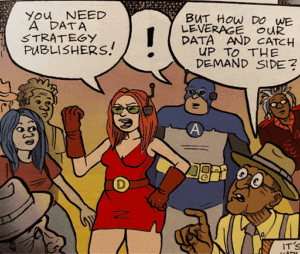 “Data-Driven Thinking” is written by members of the media community and contains fresh ideas on the digital revolution in media.
“Data-Driven Thinking” is written by members of the media community and contains fresh ideas on the digital revolution in media.
Today’s column is written by Eric Picard, CEO at Rare Crowds.
I was recently told by an executive in a position to know that 70 to 80% of revenue in the RTB space comes from retargeting. I found that stunning because it basically tells us that the RTB space is incredibly immature. If the vast majority of revenue in the space is retargeting, then nearly all the spending comes from ecommerce companies.
That means we have huge upside in this space because ecommerce companies certainly don’t make up anything near the majority of advertising spending.
Nearly 90% of advertising spend “all-up” is done on a targeted reach basis. In other words, the advertiser has come up with an ideal marketing persona (or series of marketing personas – many brands have five to 10 defined marketing personas) and their media plan is designed to reach people matching that persona. Using old-school methods, such as Nielsen or comScore, they find publishers with audiences matching their marketing personas, and that’s where they’ll buy impressions.
The problem is that this is extremely inaccurate, and wastes budget by spreading it across the whole audience that visits this publisher. On one hand, it’s wasteful because it pushes the message on audiences that don’t match campaign goals. On the other hand, it’s OK if there’s some “waste” in media spending because there’s value in getting the message in front of slight target mismatches.
Case in point: I don’t have cable at home. We watch Hulu, Amazon Prime and Netflix when we consume TV content. But recently, while traveling, I saw a few hours of TV in my hotel each night. I was shocked by the vast number of pharmaceutical ads on broadcast television – especially on the news (which I hardly watch anymore).
Most ads related to conditions I’m not facing today – so in a sense those ads were wasted. But should I ever contract one of those conditions, I’ll likely remember those products exist. Or should one of my close friends or loved ones get stricken with those conditions, I’ll recall that a medication exists and engage in conversation with them.
So yes – this broadcast brand strategy certainly does have some value. As I’ve said before: There’s value in the fact that I know Dodge Ram owners are “RAM Tough.”
On the other hand, we can be much more precise now than in the past — if you can find the data. And if you believe in the methodology that created the data, there are ways to more precisely reach your target personas and target audiences of all flavors.
Find The Right Tools
Using demand-side platforms and social media marketing tools, including the self-service tools within Facebook, it’s now possible to find your target audience in a variety of ways. You can be very narrow or very broad. You can control exactly which sites on which you’ll reach that audience, or you can simply specify on which sites you don’t want to reach your audience.
For brands that are very particular about running ads only on approved content, there is the white list – a specific list of domains matching against publishers that you specifically approve to run ads on. This does limit scale, but there’s no limit on the size of the white list you can create. And there are vendors like Trust Metrics that you can use to build a custom white list for you, which both hones the targeting to sites that match your brand safety metrics and massively reduces fraud.
Or if you want, you can use private marketplaces to execute buys only on the sites you specifically negotiate with for access to their audiences over RTB. This has a lot of value for pharma and marketers that are extremely sensitive to running ads on sites that match their brand values.
If you want to specify a tightly targeted user base, one that is so targeted that it limits the audience size to only a few thousand users, you can do that using tools like Facebook’s advertising that lets you specify many different elements and tells you how limited the size of your audience is.
Or there are tools like Optim.al, which hones the audience and offers ways to expand or contract it. Or tools that let you find audiences similar to your targeting with less targeting but greater impression volume. (Disclosure: My company Rare Crowds does this.) Or you could use MediaMath’s built-in features to automatically find the right audience that performs best for your campaigns.
Nearly every company playing in the RTB space has functionality designed to meet the needs of advertisers that want to reach specific audiences, not just retarget people who visited your website or who are existing customers. There is the potential to reach people you haven’t reached before, find new customers and prospect for them.
The biggest growth sector for RTB this year is clearly going to be brand advertisers and those that use RTB for targeted reach — just like 90% of all media spending.
Follow Eric Picard (@ericpicard) and AdExchanger (@adexchanger) on Twitter.











